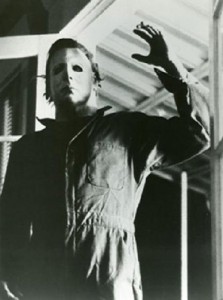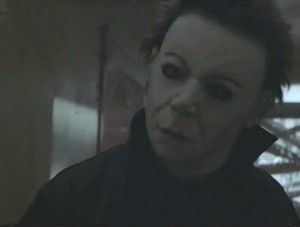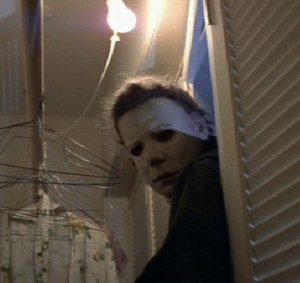 This is one of a series of posts looking at various “monsters” in different media in an attempt to understand the monster’s role in fiction. I started by trying to establish a list of criteria for what defines a monster, and then began running various iconic monsters through that checklist. I originally posted this look at Halloween‘s Michael Myers a while back, but it was one of the posts that vanished when I updated the site last year. Given the date, I decided it should finally be resurrected.
This is one of a series of posts looking at various “monsters” in different media in an attempt to understand the monster’s role in fiction. I started by trying to establish a list of criteria for what defines a monster, and then began running various iconic monsters through that checklist. I originally posted this look at Halloween‘s Michael Myers a while back, but it was one of the posts that vanished when I updated the site last year. Given the date, I decided it should finally be resurrected.
Just one quick note: this is based on the original Halloween rather than the Rob Zombie remake, which adds more backstory to the character and (in my opinion) defuses some of the fears listed below.
So here it goes:
1. Does Michael represent a primal or universal fear?
I’d argue that he represents several. Ultimately, Halloween is a classic cautionary tale, not far distant from stories like “Hansel and Gretel,” with Michael serving as the ultimate amorphous bogeyman (or “Shape” as he’s called in the credits). Among the fears he commands:
- Fear of Pure Evil. The personification of “pure evil” is an ancient concept found in numerous religions and mythologies, suggesting that this might be the most powerful and long-lived of all the fears that Michael represents. Through Doctor Loomis, the film is very clear on the point that Michael isn’t “damaged goods” or a product of a dysfunctional upbringing. Instead, he was simply “born evil,” a remorseless force of nature without the capacity for emotion or empathy. The fear of pure evil resonates because if anyone can be “born evil,” the audience is forced to ask: “Where am I safe? Who can be trusted? Am I innately evil? Is my neighbor? Are my kids?” These are unsettling questions, especially when we’re inundated with reports of detached and emotionless real-life sociopaths. Michael might be even more frightening for parents who both worry about their children falling victim to someone like Michael, but must also consider the possibilityof raising a child of “pure evil” who will never learn right from wrong and will always be compelled to hurt others no matter how much nurturing he receives.
- Fear of “Divine” Retribution. Nearly everyone can identify with the fear of getting caught and punished for doing something “bad.” In an America founded on Puritanical ideals, Michael and other slashers are the agents by which irresponsible teenagers are punished for committing various “sins,” with pre-marital sex being at the top of the list. Taking this reading to the extreme, Michaelcould be an incarnation of the archangel Michael, a “good” but still-terrifying Angel of Death who defeats Satan. (I’m not really arguing that director John Carpenter and co-writer Debra Hill consciously modeled Michael after an archangel; in fact, they’ve stated that thecharacteris named after and inspired by a distributor who worked with them on Assault on Precint 13. But it’s a nice coincidence, especially given that Tony Moran was allegedly cast as the “face” of The Shape because Carpenter and Hill wanted someone with an “angelic” appearance; see the wikipedia entry on Michael Myers).
- Fear of Strangers or Outcasts. Although Michael is technically “coming home” to Haddonfield, he is the ultimate stranger thanks to his inscrutable nature and lack of obvious connections to the people he menaces (at least until Halloween II establishes that Laurie is Michael’s sister). His psychological defects also make him an outcast among the “normal” people of Haddonfield. This fear is heightened because the film takes place on the one night each year when we are encouraged to visit strangers’ houses and open the door for strangers in masks.
- Fear of Human Nature. In contrast to being “born evil,” Michael could also represent a universal fear that we all possess the capacity to do evil: that something inside us will become so dark and twisted, or some event will make us snap and lose touch with any “good” inside of us, and we will do something horrific.
- Fear of the Opposite Sex. Halloween can be read as a twisted, abusive love story (see my previous post), with Michael representing a fear of teenage male sexualityand the emotional and physical dangers of a first crush.
2. Does Michael threaten, harm, or kill us?
In the original film, killing seems to be Michael’s only motivation. But, like real-life serial killers, he is not indiscriminate. His first murder victim is his sexually-active teenage sister Judith, whom he kills in an intimate way (stabbing) when she is extremely vulnerable (alone and half-naked). Years later, as an adult, all of Michael’s violent actions are in pursuit of emulating or reliving his initial murder again and again. His primary victims are young women who mirror Judith in some way. Those who don’t fit this profile are killed out of necessity: the truck driver’s murder provides Michael with a pair of coveralls to replace his hospital gown; the death of the Wallace’s family dog ensures that Michael will go undiscovered as he menaces the teenagers in the Wallace’s house; and Bob’s knifing allows Michael to impersonate the boy in order to sneak up on the nude Lynda and strangle her. Later, he basically ignores the two children Laurie is babysitting in order to pursue her instead.
3. Does Michael require heroic measures to contain, control, defeat, overcome, and/or escape?
Phyiscally, Michael seems impossible to contain. The first time we encounter the adult Michael, he is escaping from an insane asylum, and there’s the sense that he was just biding his time there until he felt compelled to kill again. Loomis has spent fifteen years trying to understand and “control” Michael through therapy, but has failed to make any progress.
Throughout the film, Michael is portrayed as essentially an unstoppable force of nature. Though he never runs, he is inescapable. He is strong enough to lift and carry his sister’s headstone and he seems oblivious to pain and immune to exhaustion. At the film’s conclusion, he is stabbed with a knitting needle, a clothes hanger, and his own knife. He is then shot six times, and falls from a second-story balcony. And still this doesn’t stop him: Michael simply gets up and walks away.
Later installments tried to provide Michael with “magical” powers and a confusing link to some sort of druidic cult, but the original Halloween constantly makes the audience question whether Michael is actually superhuman or simply so insane and driven that he has transcended normal human limitations.
4. Is Michael uncanny in appearance or behavior?
The first time we see Michael as a child, he has a blank, emotionless stare despite the fact that he’s just committed a terrible murder. Loomis later describes him as having a “blank, pale, emotionless face and the blackest eyes; the Devil’s eyes… What was living behind that boy’s eyes was purely and simply evil.”
Michael’s mask has become a horror icon. It is simple, yet unforgettable; featureless but still totally terrifying. The mask is an extension of Michael’s human face: emotionless, inscrutable, and pale. As others have written, it is a blank slate upon which we can project any fear. Finally, it prevents any basic human interactions: we have no way to “read” Michael or glean any insight into his emotions or thoughts. When we briefly see Michael’s adult face, it is only striking in its similarities to the mask – pale, blank, emotionless. The fact that Michael is mute further increases his sense of detachment and impenetrability.
Michael’s body language is also unsettling and childlike. Most memorable is the moment after he stabs Bob, pinning the teenager to a wall: Michael cocks his head and stares at the dying boy long enough for the audience to wonder what’s going through his mind. In other scenes – notably when he sits up after being stabbed by Laurie – his movements have a mechanical, almost robotic quality.
“Challenge, Unsettle, Warn, Inspire”
As portrayed in the original Halloween, Michael Myers is one of the most memorable film monsters of the past fifty years. He has inspired a stream of imitators, including Jason Voorhees from the Friday the 13th series and to the killers in The Strangers. He is without a doubt incredibly successful as a monster (based on my criteria, anyway).
 Unfortunately, the convoluted and often silly mythology created by the sequels and the backstory explored in the Rob Zombie remakes reduce Michael to a mildly frightening instrument of divine punishment, stripping away many of the other fears he originally engendered. Attempts to humanize him and the introduction of the “Cult of Thorns” as the source of his powers have diluted his characterization as”pure evil.” The forced connections between Michael and his victims, and the detailed origin provided in the remake, make him far less of a stranger to us than the people he kills and destroy any notion that he’s a twisted romantic. One could argue that the more we understand him, the more we can see how easy it is to “snap” and give in to the dark side of human nature, intensifying that fear. But few people can relate to being manipulated into killing their families by an ancient cult of druids, and this very notion takes away any sense of agency on Michael’s part. I’d also argue that the more specific Michael’s backstory, the easier it is for us to say “Oh, he’s not like me; I could never become that.”
Unfortunately, the convoluted and often silly mythology created by the sequels and the backstory explored in the Rob Zombie remakes reduce Michael to a mildly frightening instrument of divine punishment, stripping away many of the other fears he originally engendered. Attempts to humanize him and the introduction of the “Cult of Thorns” as the source of his powers have diluted his characterization as”pure evil.” The forced connections between Michael and his victims, and the detailed origin provided in the remake, make him far less of a stranger to us than the people he kills and destroy any notion that he’s a twisted romantic. One could argue that the more we understand him, the more we can see how easy it is to “snap” and give in to the dark side of human nature, intensifying that fear. But few people can relate to being manipulated into killing their families by an ancient cult of druids, and this very notion takes away any sense of agency on Michael’s part. I’d also argue that the more specific Michael’s backstory, the easier it is for us to say “Oh, he’s not like me; I could never become that.”
But none of this undermines the power of the original film. So, if Michael is a “successful” monster and has fulfilled his role, how does he challenge, unsettle, warn, or inspire us? I’d argue that Michael is most successful at being “unsettling” — at the end of the first film, he’s simply gone, leaving audiences to wonder when and where he’ll strike next. But if we face the fears he represents, we do leave with a greater understanding of ourselves and the human condition:
- Michael Myers and other monsters like him are meant to warn us about the dangers of “reckless behavior,” strangers, and the opposite sex. He reminds us that the world is a dangerous place, and some things and some people are bad for us. Internalizing these fears might make us safer; but ultimately overcoming them might make life more satisfying and open us up to new experiences and people.
- Michael challenges us to think about the concept of “pure evil” and whether or not it actually exists. This might make us question our religious beliefs or take a hard look at the ways in which a society deals with its worst criminals.
- As an embodiment of the dark side of human nature, Michael forces us to look within ourselves in search of our own failings and breaking points. Doing this yields a greater understanding of ourselves, and hopefully we’re stronger from the experience.

